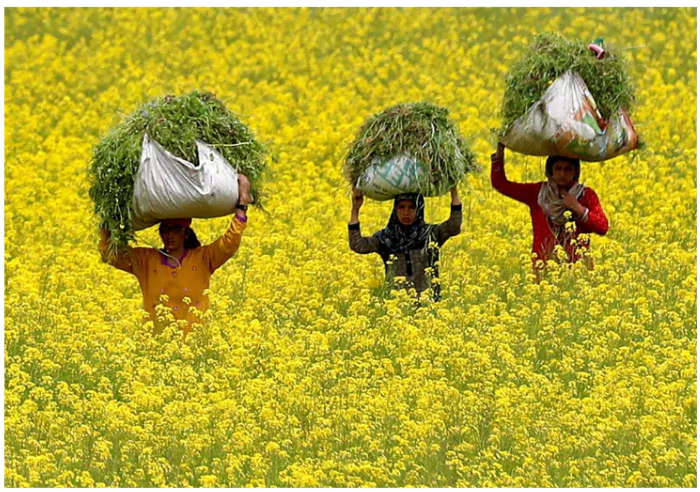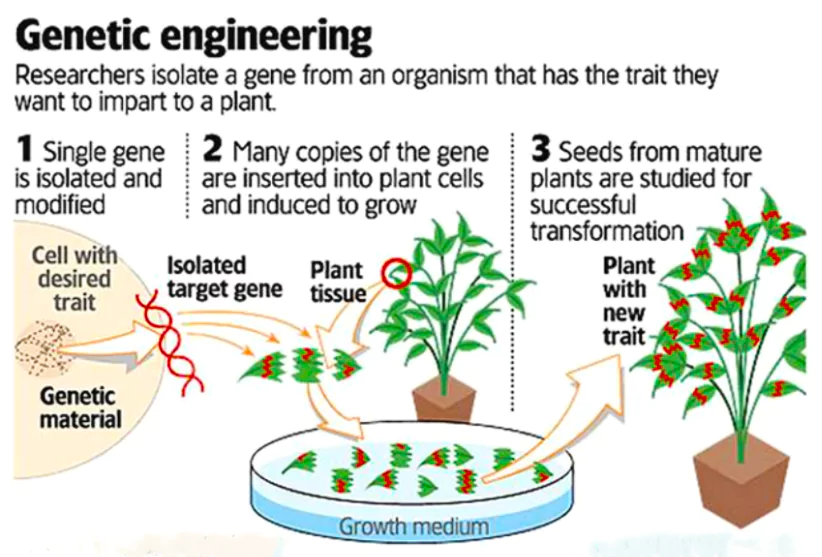The Supreme Court delivered a split verdict on the Centre’s 2022 decision to conditionally approve the environmental release of genetically modified (GM) mustard crops.
Background on GM Mustard Approval
- On October 18, 2022, the Genetic Engineering Appraisal Committee (GEAC), a regulatory body under the Ministry of Environment, Forest and Climate Change, recommended the environmental release of transgenic mustard hybrid DMH-11.
Genetic Engineering Appraisal Committee
- It is a statutory body.
- Nodal ministry: Ministry of Environment, Forest and Climate Change (MoEF&CC).
- It evaluates environmental impact of large scale use of hazardous microorganisms and recombinants in the research and industry.
- At present, it has 24 members.
- Meeting: This committee meets monthly to review applications related to responsibilities falling in committee’s areas.
|
- The Centre approved this recommendation on October 25, 2022.
- National Policy on GM Crops
- The Supreme court directed the Centre to create a national policy for GM crops.
- This policy should cover research, cultivation, trade, and commerce related to GM crops.
Enroll now for UPSC Online Course
GM Mustard (DMH-11)
- Dhara Mustard Hybrid-11 (DMH-11) is a genetically modified hybrid variety of the mustard species Brassica juncea.
- Characteristics: This variant is herbicide tolerant (HT).
 Parent Varieties of GM Mustard
Parent Varieties of GM Mustard-
- Varieties Used
- Indian Mustard: ‘Varuna’
- East European Mustard: ‘Early Heera-2’
- Cross-Breeding: The GM mustard is created by crossing these two varieties.
- Genetic Modification in Mustard
- Barnase and Barstar: Two genes are used in the modification.
- Source: These genes come from the soil bacterium Bacillus amyloliquefaciens.
- Purpose
- High-Yield Hybrids: The genes help create high-yielding commercial mustard hybrids.
- Genetic Purity: The “bar gene” maintains the genetic purity of hybrid seed.
What is Genetically Modified (GM)?
- Genetically modified (GM) refers to the process of transferring genes between organisms using laboratory techniques.
Other Methods of Genetic Modification
- Mutational Breeding: An established method for changing genomes.
- Genome Editing: A newer method
|
- Techniques: These techniques include cloning genes, splicing DNA segments together, and inserting genes into cells, collectively known as recombinant DNA technology.
- GM Crops
 GM crops are plants used in agriculture that have had their DNA modified using genetic engineering methods.
GM crops are plants used in agriculture that have had their DNA modified using genetic engineering methods.- Purpose: The goal is usually to introduce a new trait that doesn’t occur naturally in the plant species.
- Examples of GM Crop Traits
- Food Crops: Traits include resistance to pests, diseases, and environmental conditions, reduced spoilage, resistance to herbicides, and improved nutrient profiles.
- Non-Food Crops: Traits include production of pharmaceuticals, biofuels, and other industrially useful products, as well as for bioremediation.
-
GM Crop Cultivation in India
- Cotton : Bt Cotton, the first GM crop in India, began commercial cultivation in 2002-2003.
- Adoption: By 2014, 96% of cotton cultivation was Bt Cotton, making India a major GM crop producer.
- Mustard: GEAC approved two GM mustard varieties for environmental release to develop new hybrids.
- Brinjal : GEAC approved Bt Brinjal for evaluation, but the move was stopped due to public backlash.
- Ongoing Research : Research is ongoing for GM seeds of rice, wheat, sugarcane, potato, pigeon pea, lentils, chickpeas, and bananas.
Check Out UPSC NCERT Textbooks From PW Store
Advantages of Genetically Modified (GM) Crops
- Insect Resistance
-
- Toxin Production: GM crops can produce toxins from the bacterium Bacillus thuringiensis (Bt) to combat insect pests.
- Reduced Insecticide Use: These crops often need fewer insecticides.
- Virus Resistance: GM crops can resist viruses by incorporating genes from the viruses themselves.
- Herbicide Tolerance : Some GM crops can tolerate herbicides thanks to a gene from a bacterium that makes them resistant.
- Addressing Poverty and Hunger : GM crops increase yields, which boosts farmers’ incomes and improves food security, aiding in the achievement of the United Nations Sustainable Development Goals.
- Low Production Costs : GM crops typically cost less to produce because they naturally resist pests and insects.
- Drought Tolerance: GM crops are beneficial in drought-prone areas or regions with poor soil quality.
- Reduced Spoilage: GM crops often have a longer shelf life and better taste, reducing the likelihood of spoilage.
- Enhanced Nutritional Value: Genetic modification can increase the nutritional content of foods.
Challenges Associated with Genetically Modified (GM) Crops
- Ecological Concerns
- Gene Flow: Cross-pollination can lead to the spread of resistant traits to weeds, making them hard to eliminate.
- Biodiversity Erosion: GM crops might reduce biodiversity and contaminate the gene pools of endangered plant species.
- Nutritional Concerns : Focus on yield, lifespan, and pest resistance can sometimes reduce the nutritional value of crops.
- Economic Concerns: Promises of stress tolerance, better nutrition, and higher yields have often proven untrue, as seen with Bt cotton in India.
- Chemical Usage (Herbicide Use): Glyphosate, commonly used on GM crops, is considered a probable human carcinogen.
- Health Concerns
- Toxicity: There are concerns that GM foods might lead to diseases resistant to antibiotics.
- Heavy Metal Concentration: Some GM crops can absorb heavy metals from the soil, concentrating them in the plant tissue.
Enroll now for UPSC Online Classes
Acts and Rules Regulating GM Crops in India
- Key Legislations
- Environment Protection Act, 1986 (EPA)
- Biological Diversity Act, 2002
- Plant Quarantine Order, 2003
- GM Policy under Foreign Trade Policy
- Food Safety and Standards Act, 2006
- Drugs and Cosmetics Rule (8th Amendment), 1988
- Broad Coverage of Rules
-
- Research and Development: Covers all activities related to the research and development of genetically modified organisms (GMOs).
- Field and Clinical Trials: Includes regulations for field and clinical trials involving GMOs.
- Release of GMOs: Addresses both deliberate and unintentional release of GMOs into the environment.
- Trade and Manufacture: Regulates the import, export, and manufacture of GMOs.
![]() 24 Jul 2024
24 Jul 2024
 Parent Varieties of GM Mustard
Parent Varieties of GM Mustard GM crops are plants used in agriculture that have had their DNA modified using genetic engineering methods.
GM crops are plants used in agriculture that have had their DNA modified using genetic engineering methods.